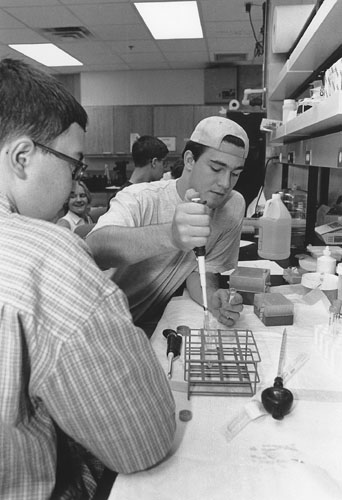Making a Successful Transition from Two- to Four-Year Colleges

Students with disabilities in two-year colleges are often unsuccessful in making the transition to four-year schools. As part of its DO-IT 2-4 project, which is funded by the Fund for the Improvement of Postsecondary Education (FIPSE), DO-IT undertook a study to document the concerns of students with disabilities in two-year institutions of higher education as they transfer to four-year schools, the perceptions of faculty and staff members regarding the challenges these students face, and recommended steps that can be taken to improve the postsecondary outcomes of these transfer students.
A survey addressed to disabled student services offices nationwide was completed by three hundred fifty-one people. In addition, twenty-one faculty and staff from seven postsecondary institutions participated in focus groups. Participants reported some of the challenges faced by transfer students to be adjusting to the differences in academic requirements and support services, having poor study and self-advocacy skills, securing financial support, working through the transfer process, and adjusting to a larger, less personal environment.
One hundred nineteen college students with disabilities also completed a survey. Students with disabilities reported their concerns to include differences in disabled student services, the cost of programs, skills in self-advocacy, differences in social life, availability of educational accommodations, access to technology, and the transfer process.
This study also reports suggestions from postsecondary faculty and staff about how two-year and four-year colleges can work separately and together to improve the postsecondary outcomes of transfer students with disabilities. They can be classified into three categories: preparation activities at the two-year level, linkage activities between two-year to four-year schools, and reception activities within the four-year institution. Focus group participants recommended that a staff member be assigned at each four-year school to facilitate activities that promote the academic and career success of transfer students with disabilities. Other proposed intervention activities include:
- Preparation: Encourage transfer students to select and apply to four-year schools early; help students develop transition plans, work through the transfer process, and develop self-advocacy skills; and educate two-year college staff about transfer issues faced by students with disabilities.
- Linkage: Help two-year and four-year institutions share information about policies, procedures, programs, and services; include transfer information for students with disabilities in publications, orientations, and Web sites; coordinate four-year college campus visits for students with disabilities; have staff of four-year schools attend two-year college career/transfer "fairs" and other events to share information with students and staff; create a summary sheet of intake and documentation requirements for all state schools; and develop a handoff system, whereby staff working with a student at a two-year school refers that student to a specific staff member at the four-year school.
- Reception: Educate staff on four-year campuses about issues specific to community college transfer students with disabilities; tailor orientation sessions for students with disabilities; include information about services for students with disabilities in all general student orientations and tours, student handbooks, publications, programs, and Web sites; and support transfer students during their stay at the four-year schools with tutoring, mentoring, and other services.
In conclusion, students with disabilities in two-year colleges face challenges as they transition to four-year schools. Some are similar to those faced by their non-disabled peers. Some challenges, however, are related to their disabilities. For example, some students lack skills in self-advocacy, while others have difficulty adjusting to the differences in disabled student services between the two types of schools. To improve the postsecondary outcomes and, ultimately, career outcomes for people with disabilities, staff members at both two-year and four-year schools should take action to make their campus services more supportive of this important transition.
For more information on this topic, a videotape and handout entitled Moving On: The Two-Four Step can be purchased from DO-IT at a cost of $25, including postage and handling.
Acknowledgement: The study described in this article was supported by grant #P116B71441 from the Fund for the Improvement of Postsecondary Education (FIPSE) of the U.S. Department of Education. The opinions, positions, and recommendations expressed in this article are those of the authors and do not necessarily reflect the views of the federal government.